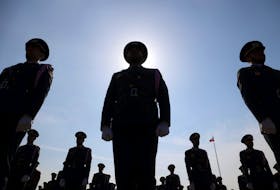It’s a battle between the Nova Scotia Tigers and the Chaleur Avalanche in Bouctouche’s J.K. Irving Centre on this frosty Friday afternoon in early February.
At the net, 10-year-old goalie Zach Fontaine is protected behind heavily-padded equipment that covers him from just under his helmet and facemask to his skates.
His father, David Fontaine, sips on a medium McDonalds coffee in the stands, able to identify his son only by his bright orange-and-navy blue team jersey with its number 31 on the back and sleeves.
Today, his son’s team emerges victorious, defanging the Tigers with a score of 5-1 in ringette tournament action.
He and his wife, Allison, have made a commitment to their five children to encourage them to lead healthy lifestyles and take part in sports.
Providing sons and daughters with opportunities to play sports is seen as part of being a good parent. It helps children develop great hand-eye coordination, tone and beef up muscles, learn to work with teammates, recognize the importance of discipline and persistence, and enhance their brains’ ability to repair itself and be mentally healthy and alert.
But buying equipment and travel costs and program registration fees, can be tough on the pocketbook.
“For a year, with the trips and everything, it’s close to $1,550,” said Fontaine.
Throughout Atlantic Canada, many families face the same financial juggling act as they try to stretch their household budget enough to allow their children to enjoy team sports.
Statistics Canada figures from 2016, the most recent year for which data is available, show the average family spends $561 on sports equipment and fees. Atlantic Canadians spent a bit less, coughing up $416.
But that’s just the average for equipment and fees. Those figures don’t include all the gas and wear and tear on the family minivan or nights in hotels during tournaments or away trips.
An Ipsos poll conducted for Global News last year shows some parents, most notably those whose kids are on teams, spend more. The typical Canadian family was reportedly planning to spend about $755 for their children who are on hockey teams last year, that polls reveals. By comparison, parents of swimmers were looking to budget about $193.
The Fontaines try hard to keep costs down by scouring websites and services for deals and buying equipment second hand at thrift shops.
“I’ve never bought skates that are new for my kids,” he said. “I buy them at the Salvation Army for around $10 to $15 for a good pair. But you need to go often and see what they have. That equipment, if it’s in good shape, it can last for years.”
The father of three ringette players, Fontaine also keeps costs down by maintaining the skates himself as much as possible.
“I bought a little tool a few years ago to remove the rust,” he said. “When we get skates, we sharpen them only once or twice a year. That’s good enough. Every time you sharpen skates, you lose a part of the blade – and it’s $6 a shot.”
During the summer, the Fontaine boys play baseball. The team jerseys, balls and helmets for batting are provided by the local minor league teams. Cleats, though, aren’t, so they rely on the league’s cleat exchange for those who outgrow their own.
At another second-hand store, Fontaine picked up five pairs of sneakers for only $5.
“There are a lot of parents who buy stuff new,” he said. “Today, with a lot of families with only one or two kids, maybe they can do that. But, me, even if I could afford it, I still wouldn’t buy new because it’s like buying a new car. There’s a lot of depreciation.”
Bargain-hunting clearly goes a long way to keep costs down. But no amount of careful shopping can make up for an insufficient income to both take care of children’s basic needs and also buy them sports equipment and pay for recreational programs.
But there there are organizations willing to support those families most in need, including the national Jumpstart and KidSport programs which have local chapters.
The KidSport program provides funding annually to cover the costs of registration and equipment for sports programs.
Canadian Tire’s Jumpstart program is another national program that provides similar help.

KidSport, Jumpstart programs offer financial help to get kids into sports
Stretching a dollar through budgeting and bargain-hunting is good but sometimes families need a bit of help to get little Johnny or Janet on the ice or the basketball court.
“It’s one of those things about sports in Canada that, when you get down to your budget, some sports have equipment needs that are prohibitive and affect families,” said Scott Gray, director of athletics and recreation at Saint Mary’s University.
“You see a lot of kids moving to the avenue of school sports because they’re covered (by provincial education budgets) and so are a little more accessible,” he said.
Enter the KidSport and Canadian Tire’s Jumpstart programs.
A national program, KidSport has branches in each of the four Atlantic Canadian provinces to help those families most in need sign their children up for sports programs. But pay attention. Each province where KidSport operates has slightly different rules to the others in terms of how much financial assistance is provided and what the criteria are to qualify.
In Nova Scotia, KidSport coughs up to $300 per child, including a maximum of $200 for sports equipment and $100 for registration fees. Once a family’s application is approved, the organization sends a voucher for the equipment costs to a sporting goods store to allow the child to get that gear. And any parent who wants to cut costs by buying used equipment is welcome to do so and provide the receipt for the gear to KidSport Nova Scotia.
“If a parent does have an ability to buy the equipment, either new or used, as long as they have a receipt for it and it is for an eligible sport, we can reimburse that,” said Colin Gillis, coordinator for KidSport Nova Scotia.
While the Nova Scotia KidSport program determines financial need on a sliding scale of family income and size, though, the Prince Edward Island chapter of the program had to limit applications last year by setting an annual income cut-off of $25,000 irrespective of the size of the family.
“Unfortunately, we just aren’t receiving enough money to help everybody,” said Gemma Koughan, executive director of Sport PEI which administers the KidSport program in that province.
In New Brunswick, eligibility for the KidSport program is based on a point system that examines such things as the number of years the child has played the sport, the parents’ income, the children’s age, and the number of years they have already received funding from the organization.
Another program widely used by families in need looking to get their children into sports and recreational programs is Canadian Tire’s Jumpstart.
It provides financial support to families for registration fees and the cost of equipment and transportation for children aged four to 18 years of age looking to take part at the house league level of 70 different activities, including hockey, soccer and swimming, martial arts and ringette.
That program determines financial need by looking to Statistics Canada’s low-income cut-offs which look at the number of people in the family and where they live.
In a bigger city like Halifax, for example, the low-income cut-off for a single parent with one child is a higher income than in a sparsely populated, rural area away from towns and villages. Similarly, two parents with a family of five children would qualify with a higher income than a single-parent family.
According to Canadian Tire’s website, families in need can apply for financial assistance for all of their children but there is a maximum of $300 over successive seasons for each activity the child is in. The annual maximum offered by the program is $600, subject to the discretion of each local chapter of the program.
Beyond these two national programs, there is help at the local level.
Saint Mary’s University, for example, rents out its recreational facilities to local school programs at a reduced rate to keep the cost of sports down, said Gray.
The university also works with families who attend sports camps and have a tough time covering the costs of those programs, which usually run about $150 for a week.








